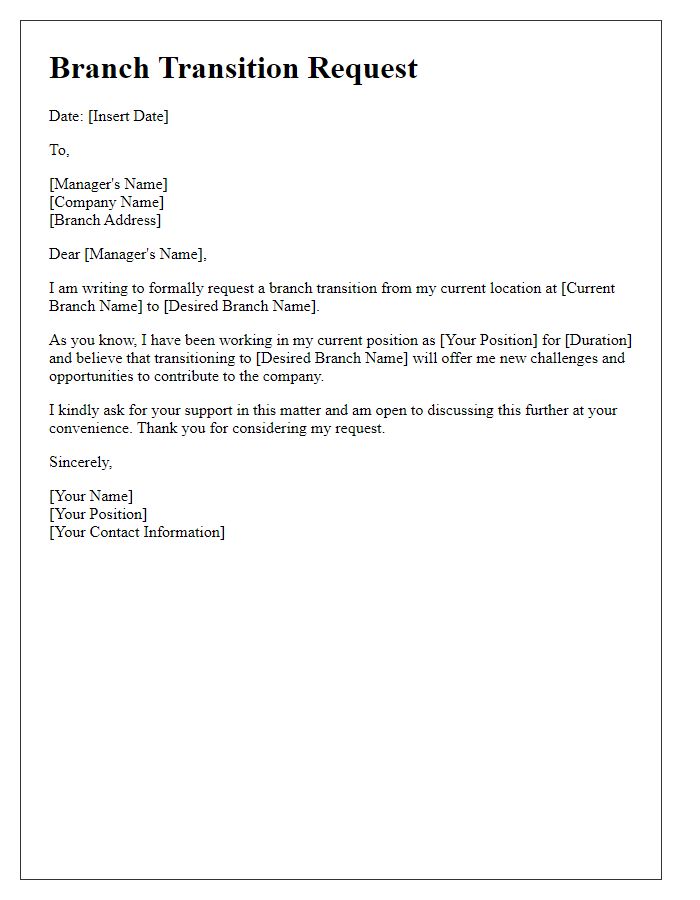Are you considering a change in your branch at college or university? Making such a decision can be both exciting and daunting, as it opens up new opportunities while also requiring you to navigate the application process. In this article, we will guide you through crafting an effective branch change application letter that clearly conveys your reasons and aspirations. Read on to discover tips and a sample template that will help you present your case convincingly!

Polite request and reason for branch change
The decision to change academic branches can significantly impact a student's educational journey. A well-structured application is crucial. This typically includes a clear expression of intent, highlighting the specific current branch and the desired branch. Providing compelling reasons, such as academic interests, career aspirations, or relevant skills, enhances the appeal. Including personal anecdotes, such as projects or experiences that fueled the desire for the new branch, offers depth. Additionally, acknowledging the support from faculty and outlining how the change aligns with institutional goals may strengthen the application. Timeliness and professional tone are important factors as well.
Current branch and desired branch details
The branch change application process often involves specific details about the current and desired academic or professional branches. The current branch may be Electrical Engineering, known for its focus on electrical systems, while the desired branch could be Computer Science, emphasizing programming and computational theory. Students should adequately highlight their reasons for the change, such as evolving career interests or specific skill development they wish to pursue in the desired branch. Additionally, they may mention relevant coursework, projects, or internships that align with the new field, demonstrating their preparedness and enthusiasm for the transition. Essential details often include student identification numbers, program codes, and administrative deadlines to ensure the application is processed efficiently.
Supporting documents or justifications
Branch change applications require clear justifications and supporting documents to enhance credibility. Essential documents include academic transcripts reflecting grades or performance metrics, letters of recommendation from faculty members highlighting capabilities, personal statements explaining motivations for the change, and relevant certificates demonstrating skills in the desired field. Additional evidence may comprise project works, behavioral evaluations, or participation in extracurricular activities showcasing leadership and teamwork. Each of these components provides essential context and solidifies the rationale behind the request for a branch change, ensuring that decision-makers have comprehensive insights into the applicant's qualifications and aspirations.
Acknowledgment of policy and process
The process of applying for a branch change within an organization involves understanding both the policy framework and procedural steps in place. Here, the company policy is designed to facilitate employee relocation or transition based on personal or professional needs. An employee should first review the eligibility criteria outlined in the policy, which typically include minimum tenure requirements or performance standards. Next, the application form must be filled out accurately, providing relevant details such as current branch (location) and desired branch (destination). A recommendation or endorsement from the current supervisor may be necessary to support the application. After submission, the HR department processes the requests, usually within a specific timeframe, providing timely feedback to applicants. Furthermore, employees might be required to participate in an interview or discussion to ensure alignment with the organization's goals and culture across branches. This structured approach helps maintain operational efficiency while supporting employee development.
Contact information for further discussion
Efficient communication is essential in the branch change application process. Providing accurate contact information enables swift follow-ups and discussions. Include your full name (e.g., John Doe), current branch location (e.g., 123 Main Street, Springfield), phone number (e.g., (123) 456-7890), and email address (e.g., johndoe@email.com). Specify preferred contact times to facilitate smoother interactions. Highlight the importance of these details for timely responses, ensuring that any inquiries or additional information required by the branch manager can be addressed promptly.
















Comments